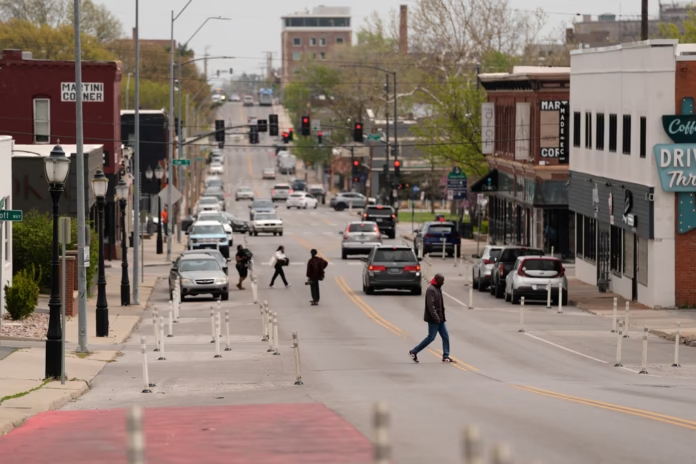In Kansas City, Missouri, a stylist had just begun her workday when a vehicle crashed through the salon’s front window, landing just feet from the waiting area. Incidents like this had become frequent along 31st Street, where business owners regularly exchanged messages and photos documenting damage from speeding cars.
The four-lane road, often used as a shortcut between major highways, had long been a concern for local shop owners. According to property owner Ryan Ferrell, “Wide roads give the impression that drivers can go as fast as they want.” Ferrell owns the building that houses the salon, a bookstore, and apartments above.
After sidewalk barriers failed to prevent vehicle-related accidents, Ferrell and others advocated for a “road diet” a traffic-calming strategy that involves reducing the number of travel lanes. This approach, used in various cities across the country, aims to improve safety for drivers, pedestrians, and cyclists by narrowing roads, slowing traffic, and enhancing walkability.
Despite the strategy’s proven track record in some areas, it has faced growing scrutiny. Federal officials previously highlighted that road diets could reduce crashes by up to 47%, but recent guidelines suggest projects that reduce lane capacity should be deprioritized. The concern, according to the U.S. Department of Transportation, is that reduced lanes may create congestion and lead to unpredictable driving behavior.
In Kansas City, a 2022 redesign of 31st Street introduced a single lane in each direction, a center turn lane near intersections, improved pedestrian crossings, and protected parking all timed with the installation of a gas line, which helped lower costs.
Elsewhere, resistance to lane reduction has emerged, particularly in states with leadership opposing what are seen as “anti-car” measures. In Texas, a plan to reduce lanes and enhance bike and pedestrian access on San Antonio’s Broadway Street was halted when the state reclaimed control of the road. Around the same time, Florida enacted legislation requiring a 180-day review process before any lane reduction project could proceed, citing concerns over efforts to restrict vehicle traffic.
Political opposition to road diets isn’t exclusive to one region or party. In California, Culver City temporarily removed traffic lanes during the pandemic to prioritize pedestrian and bike use. However, when traffic volumes rebounded and congestion increased, the changes were reversed due to public pressure.
In Kansas City, however, road diets have become a regular consideration when streets are repaved. Federal guidance traditionally recommends lane reductions for roads with fewer than 25,000 vehicles per day a category that many of the city’s multi-lane streets fall into.
As cities weigh public safety, infrastructure goals, and traffic flow, the debate over lane reductions reflects broader national discussions about urban mobility, transportation equity, and the balance between cars and alternative forms of travel.
For more political updates, visit DC Brief.


